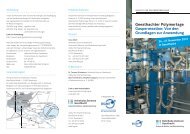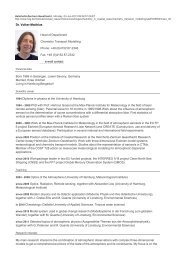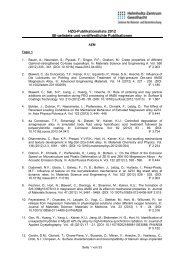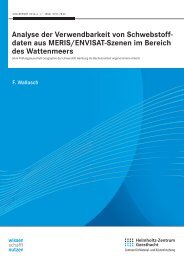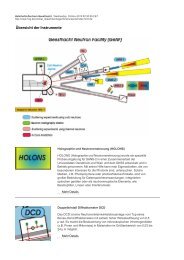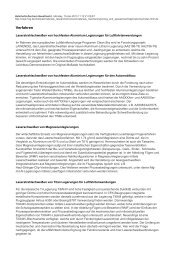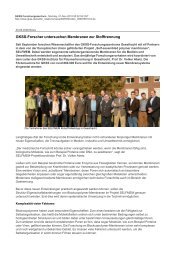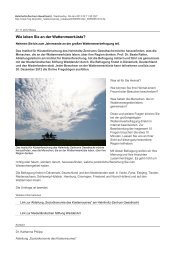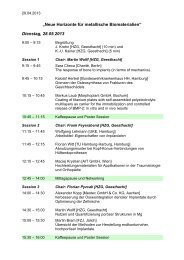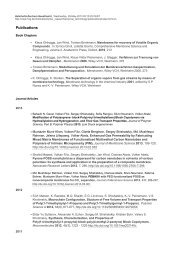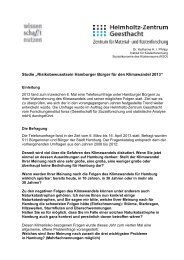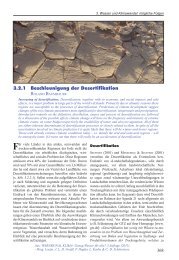Landfills and waste water treatment plants as sources of ... - GKSS
Landfills and waste water treatment plants as sources of ... - GKSS
Landfills and waste water treatment plants as sources of ... - GKSS
You also want an ePaper? Increase the reach of your titles
YUMPU automatically turns print PDFs into web optimized ePapers that Google loves.
METHOD OPTIMISATION<br />
used <strong>as</strong> carrier g<strong>as</strong> at a constant flow <strong>of</strong> 1.3 mL min -1 . 2 μL <strong>of</strong> a st<strong>and</strong>ard solution<br />
(c=1 ng μL -1 ) <strong>of</strong> each target analyte w<strong>as</strong> injected to the GC-MS using EI in the full scan<br />
mode. For PBDE m/z determination in the NCI mode (full scan) a 15 m HP-5 MS column<br />
with same diameter <strong>and</strong> film thickness <strong>as</strong> described above w<strong>as</strong> also used. The following oven<br />
program w<strong>as</strong> applied: initial temperature 40 °C, 30 °C min -1 to 130 °C; 2 °C min -1 to 240 °C;<br />
30 °C min -1 to 300 °C, hold for 20 min). This <strong>as</strong>sured the elution <strong>of</strong> all analytes in the<br />
chromatogram. The fragment occurring in highest abundance w<strong>as</strong> depicted <strong>as</strong> target ion (TI).<br />
In addition to each TI, at le<strong>as</strong>t one qualifier ion (Q) w<strong>as</strong> selected according to abundance <strong>and</strong><br />
m/z difference to TI.<br />
3.2.3 Optimisation <strong>of</strong> the oven program<br />
In order to achieve a sufficient chromatographic separation for all analytes, the oven<br />
temperature program w<strong>as</strong> optimized. 2 μL <strong>of</strong> a st<strong>and</strong>ard solution containing all native <strong>and</strong><br />
m<strong>as</strong>s-labelled PBDEs <strong>and</strong> musk fragrances (c=800 pg μL -1 ) w<strong>as</strong> injected to GC-MS (EI<br />
mode, full scan). Separation w<strong>as</strong> conducted on a HP-5 MS capillary column (Agilent, 30 m x<br />
0.25 mm x 0.25 μm).<br />
During optimisation, special attention w<strong>as</strong> given to those substances that were detected with<br />
similar m/z. Particularly, these are musk fragrances (ADBI, AHMI m/z = 229 <strong>and</strong> HHCB,<br />
AHTN m/z = 243) <strong>as</strong> well <strong>as</strong> PBDE congeners (BDE99, BDE100 m/z = 404 <strong>and</strong> BDE154,<br />
BDE153 m/z = 484). Furthermore, attention w<strong>as</strong> given to fronting <strong>and</strong> tailing <strong>of</strong> peaks.<br />
Initial oven temperature (60 °C, hold for 2 min) <strong>and</strong> (30 °C min -1 to 130 °C) were fixed<br />
parameters <strong>and</strong> not changed during the experiments. Temperature program for musk<br />
fragrances (ramp ��) <strong>and</strong> PBDEs (ramp ���) were evaluated stepwise. An overview about oven<br />
temperature programs tested in this study is presented in table 8.<br />
28



